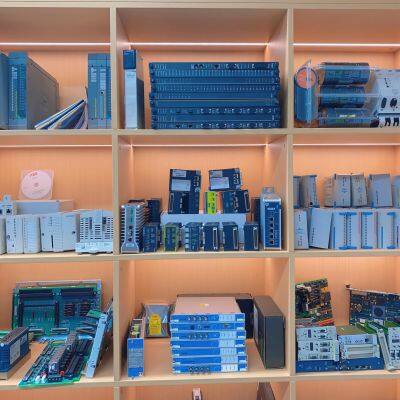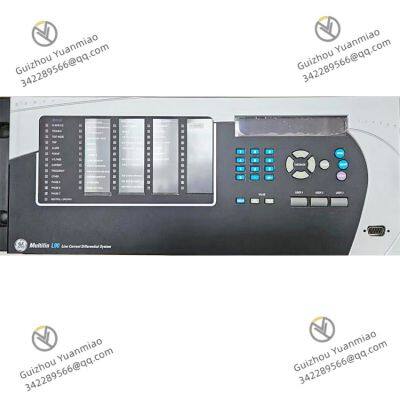Product Description
The GE Multilin L90-W03-HKH-F8L-H6P-L6C-N6C-S6C-U6L-W7G is a high-performance industrial-grade protective relay under GE’s Multilin L90 series. It is specifically designed for the protection, control, monitoring, and fault diagnosis of medium- to high-voltage power equipment (such as transformers, generators, motors, and transmission lines). Leveraging its modular hardware architecture, configurable protection logic, and multi-parameter monitoring capabilities, this device is widely used in power generation, transmission, distribution, petrochemical, metallurgical, and other industries. It serves as a core component for ensuring the safe and stable operation of power systems, effectively preventing equipment damage and power outages caused by electrical faults such as overcurrent, short circuits, and insulation failures. The following provides a detailed explanation from dimensions including model interpretation, technical parameters, hardware structure, core functions, application scenarios, and installation & maintenance, ensuring the accuracy and completeness of information.
I. Core Technical Parameters1. Electrical Input/Output Parameters
2. Protection Performance Parameters
3. Environmental and Physical Parameters

II. Hardware Structure and Functional Modules1. Core Control Unit
Dual-Core CPU Module: Adopts an ARM Cortex-A9 (1GHz clock speed) + dedicated Digital Signal Processor (DSP) architecture. The main CPU handles protection logic operations, data storage, and communication management; the DSP undertakes high-speed Analog-to-Digital Conversion (ADC) and real-time fault calculations (e.g., differential current calculation, harmonic analysis), with a protection response time ≤ 20ms (enabling rapid isolation of short-circuit faults).
ADC Module: 16-bit resolution, 200kHz sampling rate (synchronous sampling for all current/voltage channels), with a sampling time difference ≤ 1μs between channels. This ensures synchronized sampling of 3-phase current/voltage signals, avoiding calculation errors caused by asynchronous sampling (especially critical for differential protection).
Storage Module:
Flash Memory: 8GB (stores protection configuration parameters, fault records, and event logs; data retention time ≥ 10 years after power failure);
Random Access Memory (RAM): 1GB (temporarily stores real-time monitoring data and calculation results, ensuring smooth operation of multi-tasks).
2. Input/Output Modules
Current/Voltage Sampling Module: Integrates precision Current Transformers (ICTs) and voltage dividers to convert high-current/high-voltage signals from the power system into low-amplitude signals (0~5V) suitable for ADC sampling. It also includes an anti-aliasing filter (cutoff frequency: 50kHz) to suppress high-frequency interference (e.g., switching transients).
Digital Input/Output Module:
Digital Input (DI): Isolates external signals via optocouplers (isolation voltage ≥ 2500VAC) to prevent interference from the power system;
Digital Output (DO): Uses high-reliability electromechanical relays (mechanical life ≥ 100,000 operations) and is equipped with transient suppression circuits (TVS diodes) to protect relay contacts from voltage spikes.
Power Supply Module: Optional dual-redundancy design, supporting two independent DC power inputs. If one power supply fails, the other automatically takes over (switching time ≤ 100ms), ensuring uninterrupted operation of the protector.
3. Human-Machine Interface (HMI) and Communication Module

III. Core Protection and Monitoring Functions1. Comprehensive Protection Functions
The L90-W03-HKH-F8L-H6P-L6C-N6C-S6C-U6L-W7G integrates 12 types of core protection functions, covering common faults in power systems and adapting to protection needs of different equipment (e.g., transformers, generators, motors). Key functions are detailed in the table below:
2. Real-Time Monitoring and Data Analysis
Multi-Parameter Monitoring: Continuously collects and calculates electrical parameters of the power system, including:
Basic electrical quantities: 3-phase current (Iₐ, Iᵦ, I𝒸), 3-phase voltage (Uₐ, Uᵦ, U𝒸), line voltage (Uₐᵦ, Uᵦ𝒸, U𝒸ₐ), frequency (f, measurement accuracy ±0.01Hz);
Power parameters: Active power (P), reactive power (Q), apparent power (S), power factor (cosφ, measurement accuracy ±0.5%);
Energy metering: Cumulative active energy (kWh) and cumulative reactive energy (kVARh) (compliant with IEC 62053-21/22 Class 0.5 accuracy standards).
Waveform Recording: Automatically records current/voltage waveforms when a fault occurs (2 cycles before the fault, 10 cycles after the fault, sampling rate 200kHz). Waveform data can be exported in COMTRADE format (a standard format for power system fault records) for offline analysis (e.g., identifying fault types, locating fault points).
Trend Analysis: Stores historical data of key parameters (current, voltage, temperature) at configurable intervals (1 minute ~ 1 hour) and generates trend curves (e.g., 24-hour current trend, weekly temperature trend). This helps users identify equipment aging, load changes, or potential faults (e.g., a gradual increase in transformer winding temperature indicating insulation degradation).
3. Control and Configuration Flexibility
Remote Control: Supports remote operations via communication interfaces (Ethernet/RS-485), including:
Tripping/Closing: Remote control of circuit breakers (requires password authentication to prevent misoperation);
Parameter Adjustment: Remote modification of protection settings (e.g., overcurrent threshold) without on-site operations (reducing maintenance costs for remote power stations);
Firmware Upgrade: Remote upgrade of the protector’s firmware via Ethernet to add new functions (e.g., supporting new protection algorithms) or fix bugs.
Logic Configuration: GE’s dedicated software "Multilin EnerVista" provides a "graphical logic editor", allowing users to combine basic protection elements (e.g., overcurrent, undervoltage) with digital inputs/outputs to customize protection logic. This meets special protection needs (e.g., interlocking protection for multiple transformers, backup protection for specific scenarios).
IV. Application Scenarios and Typical Deployments1. Power Generation Industry
Applicable Equipment: Main transformers, auxiliary transformers, and generators in thermal power plants, hydropower plants, and wind farms;
Deployment Method: Installed in the control cabinet of power generation units (e.g., transformer control room, generator control panel). The protector is connected to the CTs/VTs of the transformer/generator and to the plant’s DCS system via Ethernet;
Core Roles:
Protect transformers from faults such as short circuits, overexcitation, and excessive oil temperature;
Monitor the generator’s output voltage/current and frequency, and trip the generator circuit breaker in case of overcurrent/overvoltage to prevent damage to the stator and rotor;
Upload real-time data (power, energy) to the DCS for load scheduling and energy metering.
2. Power Distribution Industry
Applicable Equipment: Medium-voltage distribution transformers (10kV/0.4kV), distribution lines, and switchgear in industrial parks, commercial buildings, and residential areas;
Deployment Method: Installed in medium-voltage switchgear (e.g., 10kV ring main units, distribution cabinets). The protector is connected to the line’s CTs/VTs and to the distribution SCADA system via RS-485/Ethernet;
Core Roles:
Detect single-phase earth faults in distribution lines (common in 10kV systems) and trigger timely alarms or trips to prevent fault escalation;
Monitor the load current and temperature of distribution transformers, and issue alarms in case of overload to prevent transformer burnout;
Record fault information of the distribution system to assist maintenance personnel in quickly locating fault points and shortening power outage duration.
3. Industrial Enterprises (Petrochemical, Metallurgical)
Applicable Equipment: Large motors (e.g., compressors, pumps, fans), on-site high-voltage transmission lines, and transformers in self-owned power stations;
Deployment Method: Installed in workshop electrical control rooms or self-owned power station control cabinets. The protector is connected to the CTs/VTs of the motors/lines and integrated into the enterprise’s industrial control system
 II. Hardware Structure and Functional Modules1. Core Control Unit2. Input/Output Modules3. Human-Machine Interface (HMI) and Communication Module
II. Hardware Structure and Functional Modules1. Core Control Unit2. Input/Output Modules3. Human-Machine Interface (HMI) and Communication Module

ABB 086339-501 Digital Input Module
ABB 086348-001 PC Board
ABB 086444-005 Measurement Process Board
ABB RMU610 2VAA008425R1 Repeater Mounting Unit
ABB CHBX01L 2VAA008574R1 Compact Bus Extender
ABB CHBX01R 2VAA008575R1 Compact Bus Extender
ABB UFC921A 3BHE024856P106 Communication Module
ABB PP886 3BSE092980R1 Operation Panel
ABB SUE3000 1VCF750090R0804 Maintenance Exchange Unit
ABB SUE3000 1VCR007346 G0032 REF542plus HMI Unit
ABB GFD563A101 Interface Module
ABB 3BHE046836R0101 Interface Module
 yezi
Hi there! Welcome to my shop. Let me know if you have any questions.
yezi
Hi there! Welcome to my shop. Let me know if you have any questions.





